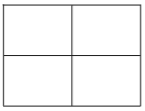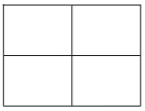4.3: Genetics Supplementary Document
- Page ID
- 25095
Introduction
We all know that children tend to resemble their parents. Parents and their children tend to have similar appearance because children inherit genes from their parents and these genes influence characteristics such as skin and hair color.
How do Genes Influence Our Characteristics?
A gene is a segment of a DNA molecule that gives the instructions for making a protein. Different versions of the same gene are called alleles, and different alleles give the instructions for making different versions of a protein. The chart below gives an example.
| Gene in DNA | ⇒ | Protein |
| 'A' allele provides instructions for making normal enzymes. | ⇒ | Normal enzyme for producing melanin, the molecule that gives color to our skin and hair |
| 'a' allele provides instructions for making defective enzymes. | ⇒ | Defective enzyme that cannot make melanin |
Each cell in your body has two copies of each gene (one inherited from your mother and one inherited from your father).
- If both copies of a gene have the same allele, the person is homozygous for that gene.
- If the two copies of a gene have different alleles, the person is heterozygous for that gene.
The two alleles determine which version(s) of the protein is made by your body's cells, and the different versions of the protein can result in different characteristics. In other words, genotype (the genetic makeup of a person) determines which version(s) of the protein is made and the proteins influence the phenotype (the observable characteristics of a person).
| Genotype | ⇒ | Protein | ⇒ | Phenotype (characteristics) | |
| AA or Aa | ⇒ |
Enough normal enzyme to make melanin, the molecule that gives color to our skin and hair. |
⇒ |
Normal skin and hair color |
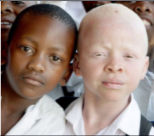 |
| aa | ⇒ |
Defective enzymes that do not make melanin |
⇒ |
Very pale skin and hair color (albino) |
|
1. Circle the genotypes in the chart that are homozygous. Explain how the two different homozygous genotypes result in different phenotypes. What is the molecular mechanism?
2a. In a heterozygous person, often a dominant allele determines the phenotype and the other recessive allele does not affect the phenotype. This means that a heterozygous person has the same phenotype as a person who is homozygous for the ___________________ (dominant/recessive) allele.
A person who is heterozygous Aa has the same phenotype as a person who is homozygous AA because skin cells that have at least one 'A' allele produce enough melanin to result in normal skin color.
2b. For this gene, which allele is dominant? ___A ___a
- Which allele is recessive? ___A ___a
- What evidence supports your conclusion about which allele is dominant and which is recessive?
How does a Baby Inherit Genes from his or her Mother and Father?
Each gene is a part of a DNA molecule which is contained in a chromosome. During meiosis, the gene-carrying chromosomes move from the parent’s cells to the gametes, and during fertilization, the gene-carrying chromosomes move from the gametes to a zygote which develops into a baby. Thus, we can understand how a baby inherits genes from his or her mother and father by understanding how the gene-carrying chromosomes move during meiosis and fertilization.
Inheritance of Albinism
To learn more about how genes are inherited, we will start with a specific question:
- If both parents are heterozygous (Aa), what different combinations of 'A' and/or 'a' alleles could be observed in the children of these parents?
3. Begin by completing this diagram to show how meiosis produces sperm in the father.

What is the genetic makeup of the different types of sperm that an Aa father can produce? ____ or ____
What would be the genetic makeup of the different types of eggs that an Aa mother can produce? ____ or ____
4. Label the allele (A or a) on each chromosome in these diagrams to show how fertilization of each different type of egg by each different type of sperm produces different combinations of alleles in the different zygotes.
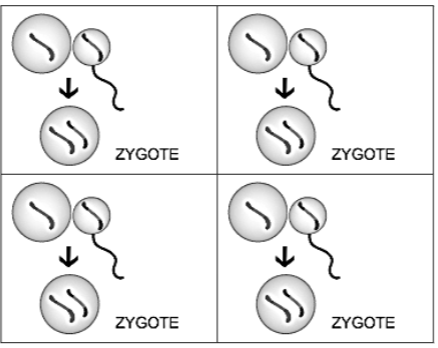
This chart combines the results of meiosis and fertilization for an Aa mother and Aa father. It shows the genetic makeup of the different zygotes that this couple could produce.
Each zygote undergoes repeated mitosis to become a child, so the child has the same genetic makeup as the zygote.
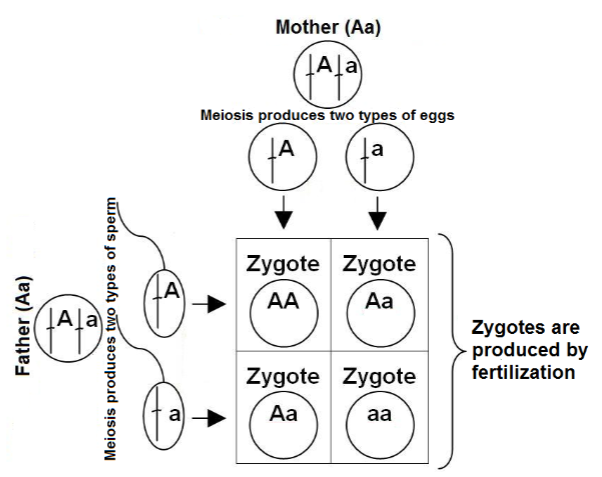
5. For this Punnett square:
- Write "gametes" and draw arrows to each symbol that represents the genetic makeup of a gamete.
- Write "zygotes" and draw arrows to each symbol that represents the genetic makeup of a zygote.
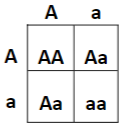
6. The genetic makeup of each zygote in the Punnett square represents a possible genotype of a child of this couple. Explain why the genotype of each child is the same as the genetic makeup of the zygote that he or she developed from.
7. For an 'Aa' mother, what fraction of her eggs have an 'a' allele? _____
- What fraction of an Aa father's sperm have an 'a' allele? _____
- What fraction of this couple's children would you expect to have the 'aa' genotype? _____
- Explain your reasoning.
|
8a. Complete this Punnett square for two parents who are homozygous AA.
|
8b. Complete this Punnett square for two parents who are homozygous aa.
|
8c. Complete this Punnett square for a mother who is heterozygous Aa and a father who is homozygous aa.
|
9. For each of the four Punnett squares above, circle the genotype of anyone who would have normal skin and hair color.
- In these four Punnett squares, there is only one example of a child who would have a different phenotype that was not observed in either parent. Use an asterisk (*) to indicate this example.
Notice that all of the children with normal skin and hair color have at least one parent who also has normal skin and hair color. Also, almost all of the albino children have at least one albino parent. These findings fit with our general observation that children tend to resemble their parents.
10. Explain why two albino parents will not have any children with normal skin and hair color, but two parents with normal skin and hair color could have an albino child.
11. Albino children are rare in the general population. Based on this observation, what is the most common genotype for parents? Explain your reasoning.
Genetics of Sex Determination
As you probably know, human males have an X and a Y chromosome (XY), whereas females have two X chromosomes (XX). A crucial gene that stimulates the development of male anatomy is located on the Y chromosome. This gene is called SRY, which stands for Sex-determining Region of the Y chromosome. If a zygote has a Y chromosome with the SRY gene, the embryo will develop testes and male anatomy. If a zygote does not have a Y chromosome with the SRY gene, the embryo will develop ovaries and female anatomy.
1. In the figure below, label each cell with the appropriate symbols (X, Y) for the sex chromosome or chromosomes. For meiosis, show the cells in the mother on the left and the cells in the father on the right. Show fertilization for a zygote that will develop into a female on the left and a zygote that will develop into a male on the right.
Meiosis
Fertilization

2. Complete this Punnett Square to show the inheritance of the sex chromosomes. Use X and Y to indicate the genetic makeup of the gametes and zygotes.
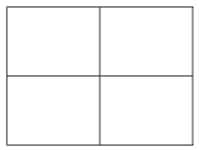
3. Based on this Punnett Square, what percent of children would you expect to be male?
4. To test this prediction, begin by writing down the initials of all the children your mother has had. Arrange these initials in order from the youngest to the oldest, indicating whether each was male or female.
- Use this information and the information from the other students in your group to complete the upper rows of the table on the next page. Calculate the total number of children and the total number of males for your group, and give this information to your teacher.
5. Complete the following table.
| Sex of Each Child | Total Number of Children | Total Number of Males | % Males | |||||||||||
| 1st | 2nd | 3rd | 4th | 5th+ | ||||||||||
| Your Mother's Children | ||||||||||||||
| Children of the Mother of Another Student in Your Group | ||||||||||||||
| Children of the Mother of Another Student in Your Group | ||||||||||||||
| Children of the Mother of Another Student in Your Group | ||||||||||||||
| Totals for Your Group | ||||||||||||||
| Children of the Mother of All the Students in Your Class | ||||||||||||||
| Predicted Percent Male (based on Punnett Square) | ||||||||||||||
6. Use your group's data and data from nearby student groups to answer the following questions.
- If a mother's first child is a son, is the next child necessarily a daughter?
- If a mother's first child is a daughter, is the next child necessarily a son?
- If a mother's first two children are the same sex, is the next child necessarily the opposite sex?
Notice that you cannot predict the sex of the next child based on the sex of the previous child or children. The reason for this is that the sex of each child depends on whether an X or Y sperm fertilized the egg, and this is not influenced by what happened during the fertilization that resulted in previous children.
7. Compare the predicted percent male with the observed percent male for each mother who had two or more children. Use an arrow to indicate any of these families that had <33% male or >67% male (considered to be substantially different from predicted). Check the results for the other student groups that are near you.
- Explain why the observed percent male differs from the Punnett square prediction in many families of two or more children.
8. Your teacher will provide the class results to enter in the next-to-the-last row of table. Is the result for the whole class <33% male or >67% male (i.e. substantially different from the Punnett square prediction)? ___ yes ___ no
Random variation in which sperm fertilizes which egg often results in differences between the observed percent male and the Punnett square prediction. However, random variation usually averages out in large samples, so the observed percent male is usually closer to the prediction.
Pedigree Analysis
Geneticists illustrate the inheritance of a gene within a family by using a pedigree chart. In a pedigree chart, males are symbolized by a square (□) and females are symbolized by a circle (○). People who are affected by a condition or disease are symbolized by a dark square or circle.
This pedigree chart shows the inheritance of albinism in three generations of a family. The couple labeled 1 and 2 had five children, including one albino daughter (5). One of the sons (3) and his wife (4) had four children, including one albino son (6).
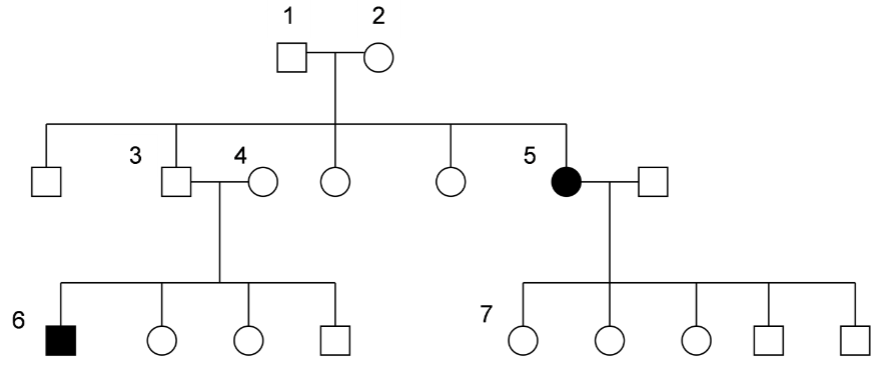
1. You will write the genotypes of each individual who is labeled with a number in the pedigree. Use 'A' to represent the dominant allele and 'a' to represent the recessive allele. Begin by writing in the genotypes of 5 and 6. How do you know their genotypes?
- Explain how you can determine the genotypes of 1 and 2. Include the Punnett Square for these parents in your explanation. Write their genotypes in the pedigree.
- Write the genotypes of 3 and 4 in the pedigree.
- Explain how you can figure out the genotype of 7 and write her genotype in the pedigree.
Many other conditions are the result of homozygous recessive alleles, so these conditions are inherited in the same manner as albinism. These include:
- Cystic fibrosis (a genetic disease that results in difficulty in breathing and serious illness)
- Phenylketonuria (a genetic disease that results in mental retardation unless phenylketonuria is detected at birth and treated with a special diet).
This pedigree shows the inheritance of a different condition called achondroplasia (ay-kon-druh-play-zhuh), a form of dwarfism. Dark circles or squares represent individuals with achondroplasia.
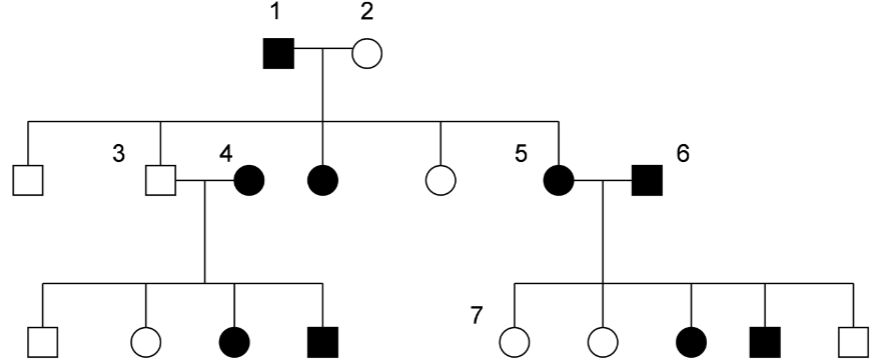
2. Think about 5 and 6 and their children. Based on this family, is the allele that causes achondroplasia recessive or dominant? How do you know? Include a Punnett square for 5 and 6 and their children in your answer. Use 'D' to represent the dominant allele and 'd' to represent the recessive allele.
- Write the genotypes of 5 and 6 in the pedigree.
- Write the genotypes of 2, 3 and 7 in the pedigree. How do you know their genotypes?
- Determine the genotypes of 1 and 4. Show a Punnett square and explain your reasoning. Write the genotypes of 1 and 4 in the pedigree.
3. Based on the frequency of dwarfs among the people you have seen in your lifetime, do you think that the allele for achondroplasia is common or rare in the population? Explain your reasoning.
Challenge Questions
4. Most people who have the achondroplasia allele did not inherit this allele from their parents. For a person who has the achondroplasia allele, but did not inherit it from his or her parents, what biological process is the most likely explanation for this person’s achondroplasia allele? We have analyzed two types of models of inheritance: a Punnett Square and a pedigree. A model is a simplified representation of a biological process that demonstrates important aspects of the process. Models can make it easier to understand the important features of a complex biological process.
5. What are some advantages of a Punnett Square as a model of inheritance?
- What is one limitation of a Punnett Square as a model of inheritance?
- What is one advantage of a pedigree as a model of inheritance?
- What is one limitation of a pedigree as a model of inheritance?


